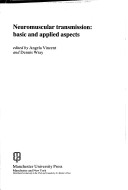Studies in neuroscience
1 total work
No 12
Neuromuscular Transmission
Published 31 January 1991
The transmission of impulses from nerve to muscle depends on a very rapid sequence of events beginning with the opening of voltage-dependent calcium channels in the presynaptic nerve terminal and ending with the generation of an action potential in the muscle fibre. The ready accessibility of the neuromuscular junction has made the whole process a prototype for synaptic interactions in general and over the last two decades, study of neuromuscular transmission has evolved to the extent that many of the events can be identified at the molecular level and related to specific membrane proteins. This book aims to provide an interdisciplinary account of the structure and development of the neuromuscular junction, the biochemical and physiological events associated with neuromuscular transmission, the use of neurotoxins as probes and the molecular structure of the highly specialized ion channels and other proteins involved. Throughout there is an emphasis on the application of modern techniques. It is hoped that this approach may stimulate the interest of students in many biological fields and provide a useful reference source for postgraduates and clinicians.
